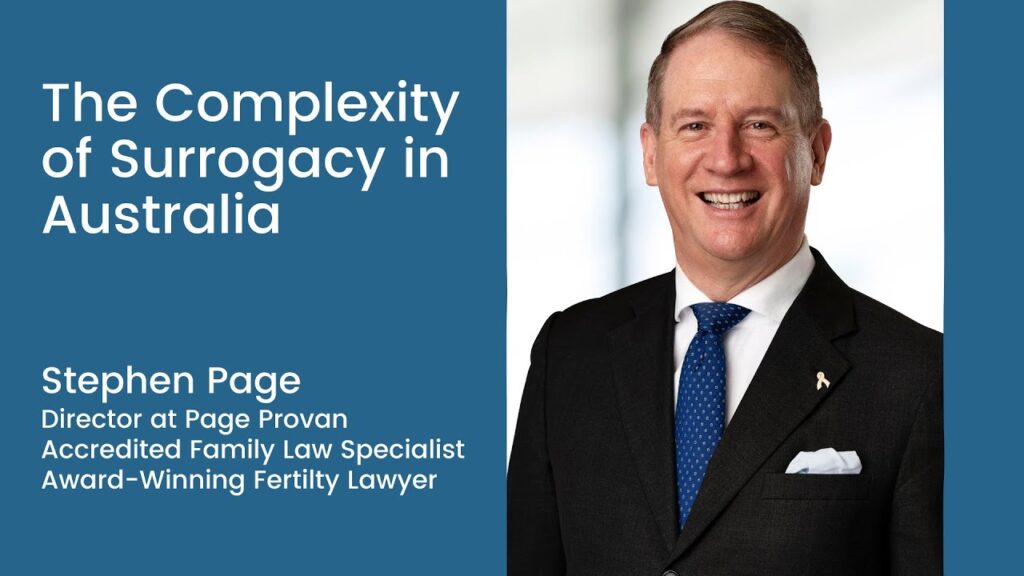World first decision about what is conception made by Qld judge
For natural conception, there is no difference, but with IVF there can be a significant difference. An embryo can be created from egg and sperm and then be frozen, sometimes for years, before being implanted in the mother to be to enable her to become pregnant.
The significance in Queensland is that the Surrogacy Act (Qld) requires a surrogacy arrangement to be signed “before the child was conceived“. If a frozen embryo were used, and fertilisation were conception, then the surrogacy arrangement was almost certainly signed after the child was conceived, meaning that an order transferring parentage from the surrogate to the intended parents could not be made.
Similarly in New South Wales, there is a requirement for the surrogacy arrangement to be a “pre-conception” surrogacy arrangement. Neither in Queensland nor in New South Wales is “conceived” nor “conception” defined in the legislation. There has therefore been doubt about what approach judges would take, given the consequences.
In the case before Judge Clare, which cannot be named due to privacy requirements, the embryo was created in 2008, the surrogacy arrangement was signed in April 2011, and implantation occurred in July 2011.
Judge Clare stated:
The meaning of the term “conceived” as used in s 22(2) (e) (iv) [ of the Surrogacy Act] is critical to the court’s jurisdiction in this case. This is because the embryo was created years before the surrogacy arrangement, then frozen and not implanted in the uterus until months after the written arrangement was settled. The question now is whether the reference to pre conception as the cut off point in s 22(2)(e)(iv) means before the creation of the embryo or simply any time before the transformation of the embryo into a pregnancy. If it were an earlier point in time, the court would have no power to make a parentage order for [the child].What does “conceived” mean?The act offers no definition. It seems this is the first time a court has been asked to interpret s22 (2) (e) (iv). Nonetheless, the answer seems obvious. Whatever approach to statutory interpretation is applied, whether it be to view “conceive” as a technical term, or it its everyday meaning, or the meaning that best advances the purposes of the Act, the result is the same. The point of conceiving a child is the commencement of the pregnancy, which involves an active process within a woman’s body.The everyday meaningThe phrase “conceived a child” is in common usage. It is commonly understood to refer to an actual pregnancy.One must examine the context of the provision[1]. This is a provision about surrogacy. As expressed in s.5, the purpose of the Act is to safeguard the interests of the child and regulate surrogacy agreements. There is an underlying intention to protect the birth mother from duress to surrender her child. Such issues only emerge after a pregnancy occurs. The Act applies to all forms of conception. The use of in vitro fertilisation is now widespread. In my experience when lay people talk about IVF treatments they tend to reserve the term “conceive” for the circumstance where an embryo actually takes to the uterus and the woman succeeds in becoming pregnant as distinct from the procedure of implantation. I am satisfied that in the ordinary everyday language of the community, the term “conceive a child” means more than what can be achieved in a test tube and refers to the commencement of a pregnancy in a woman’s body. This is consistent with the current editions of both the Oxford English dictionary and the Macquarie Dictionary. They define “conceive” as, inter alia. “to become pregnant”. The former publication also defines “conceived”, the adjective, as “brought into embryonic existence in the womb”.To construe the cut off point in s 22 (2) (e) (iv) as the point of pregnancy (and therefore after fertilisation) is also consistent with the definition of “surrogacy arrangement” in s 7 of the Act.The (intended mother’s) eggs were fertilised and preserved before she underwent the emergency procedure that saved her life but left her unable to carry her own children. This was before the Surrogacy Act had come into existence. It was therefore impossible for her to enter into an arrangement under the Act before the embryos were created. The same situation is readily foreseeable for any woman undergoing emergency procedures even after the commencement of the Act. A woman desirous of having a baby, would little hope of securing a compliant surrogacy arrangement in advance of an emergency hysterectomy, given the requirements for the identification of a willing surrogate, proper counselling and legal advice with time to reflect on all of the implications. The Act is intended to help such people in genuine need of surrogacy.Therefore to interpret the preconception condition as a condition to be satisfied before fertilisation would not only be contrary to the ordinary language of the provisions, it would frustrate the underlying intention of the Act. There is no reason to reach beyond the common language for the interpretation of s 22 (2) (e) (iv).The expert evidenceThe Court has an affidavit from … an obstetrician and gynaecologist involved in the case, as well as various definitions from medical dictionaries. Of course the construction of the statute is a matter for the court, not doctors, but the expert evidence of the biological processes is relevant to that task. According to [the doctor]:“The creation of the embryos in 2008 was an act of fertilization. Fertilization is a step on the path way to conception. Many eggs fertilize but many fewer pregnancies are conceived. The act of conception or the act of conceiving the pregnancy was the actual embryo transfer and the subsequent implantation of that embryo into the uterus of [the birth mother] over the next couple of days with the eventual positive pregnancy test approximately two weeks after …July 2011… The act of conceiving in this case is viewed as the act of achieving a pregnancy. Therefore, I view the conception of [the child] as occurring from the embryo transfer on … July 2011.”[The doctor]’s professional distinction between the processes of fertilisation and conception is consistent with the common understanding of what it means to conceive a child. The same can be said of the preponderance of definitions from the medical dictionaries cited.Despite extensive research, the parties have found only one case in which the meaning of conception was considered. This is the English case of R ( John Smeaton on behalf of the Society for the Protection of Unborn children) v the Secretary of State for Health.[2] It was about the morning after pill and therefore considered conception through sexual intercourse rather than scientific intervention.












